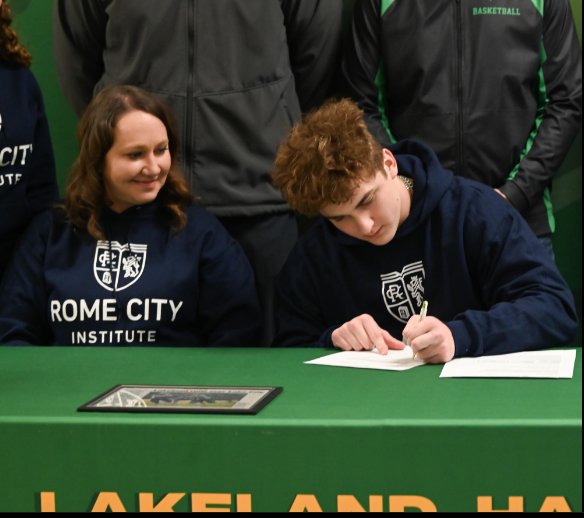Hours and hours practicing the sport you love, all to improve your skill, and make the varsity team, will eventually lead to the question, should I continue playing in college?
Throughout highschool playing sports mostly revolves around making varsity and being placed on the starting line up. But, thinking about the sport ending after years of playing the game can be heartbreaking, so some athletes choose to pursue their sport in college. Whether it is JUCO, NAIA, D3, D2, and D1.
At Lakeland High School, several student athletes have taken the next step-
Delilah Zimmerman, a junior, is committed to play softball at the D2 level for Montana State Billings.
Lovie Weil, a senior, will be attending Arizona Christian University to play at the NAIA level.
Landree Simon, another senior, is headed to University of Providence for basketball at the NAIA level.
Crater Vanek, another senior, will be attending Carroll College to play football at the NAIA level.
The college coaches are allowed to start reaching out to high school athletes after their sophomore year of high school and begin to talk to them about continuing their athletic and academic journey.
They can offer paid visits and scholarships, to encourage the athlete to pick their school.
The rule in college used to be play on the team for four years but if the athlete red shirts they can play five, but now as of December 2024, The NCAA granted a waiver allowing former JUCO an additional year of eligibility.
With this new rule athletes can enhance and sharpen their skill at the JUCO level while not hurting their NCAA eligibility. Making JUCO a more popular path to choose from, while also increasing the competition for roster spots at the higher levels. Especially for high school athletes because the coaches might prefer a JUCO transfer over a high school athlete.
This also opens the opportunity to pursue more advanced degrees while still competing in their sport.
“I think the new JUCO rule will make it easier for them to get into the higher level after they are used to the idea of college sports,” Zimmerman said. “If I had the choice now I would go JUCO first.”
It has been done where athletes who have been to JUCO colleges originally and moved up have gone to the professional level.
“No, I would not change schools with the new JUCO rule because my school has a NAIA and a JUCO team so I can get two years there and keep four years of eligibility,” Weil said.
Cam Newton a football player who went to Blinn College to Auburn university to the NFL.
There are so many stories out there of athletes who started at a lower level and worked their way to the top.
“I didn’t really have many options; they were the only school that was really willing to give me an opportunity,” Weil said. “My goal is to get better and possibly go to a better school after that and keep all my years of eligibility as possible.”
Wherever the starting point is will never determine where the end will be.
Each level of college sports offers different opportunities.
JUCO is a to year program to get a higher level of experience before possibly going to a higher division. JUCO can offer scholarships and full rides are possible. The academic program is typically a two year program in general studies.
The NAIA is a different governing body from the NCAA. They have many small private colleges. The competition is comparable to D2. In many NAIA schools they play NCAA schools as non-conference games. NAIA offers athletic scholarships and because of flexible rules, they can offer packages that combine athletic and academic aid.
“I love the game and I got the opportunity to play and it paid for my college, so I might as well continue it,” Vanek said. “It gives me the best options for education while giving me the opportunity to play at the next level.”
There is a less intense workload than offer divisions allowing more of a balance between sports, academics, and personal life.
Simon would not change her choice in college with the new JUCO rule; she loves the chemistry of her team and thinks everything is perfect as it is.
“Just looking forward to being around college athletes to make me better in the game and outside,” Simon said.
NCAA D3 are schools that will prioritize academics first before sports, so therefore no athletic scholarships. Other ways to get money are merit aid or different types of scholarships. The workload is less intense allowing more of a student life, pursuing internships, and even study abroad.
NCAA D2 are schools that focus more on a balance between academics and athletics. They are often mid-sized schools. They can offer athletic scholarships but are usually only partial. Athletes can combine athletic aid with academic or need based scholarships. The competition level is strong because some athletes could have gone D1 but chose D2 for a better balance with academics. There is flexibility in the work-load for internships and academics, but a lot of time goes into athletics.
Zimmerman chose to go the D2 route because it is less competitive and more laid back giving her a more flexible schedule in college.
NCAA D1 these schools have the larger student population, bigger athletic budgets, and the most media coverage. They can offer full ride athletic scholarships mostly in their high level sports. The work-load will be extremely demanding, with intense training, traveling, and academic responsibilities. Athletes are typically the bets in the country and may be on the path to going to play professional.
Five different levels of college competition opens so many doors for young athletes wanting to continue their athletic and academic careers.
“I had a sneaky suspicion that I might be able to play in college my freshman year and a lot of people told me I could but I didn’t really believe it but now I am here and it is real” Vanek said.
Hundreds and hundreds of schools with so many different sports and majors. The choice can be challenging but each level and school holds different opportunities, for different wants and needs.
“Work hard,” is Simon’s advice for younger athletes hoping to continue their sport in college.

